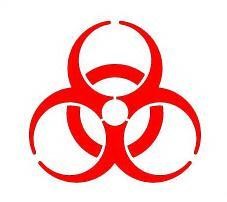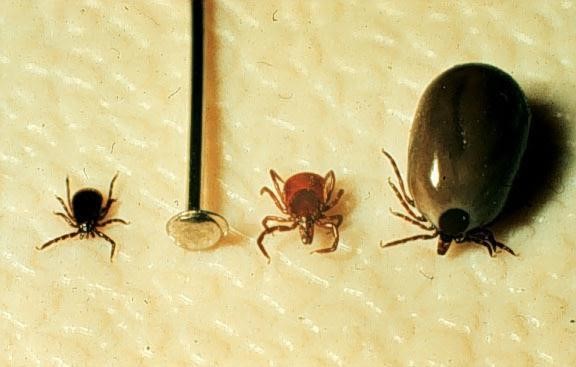Module 3 Wildlife Diseases
Module 3 provides basic information about wildlife diseases, specifically those that wildlife may transmit to humans, called zoonotic diseases. Everyone needs to be aware of the dangers of wildlife diseases and how to safely avoid infection, as well as reduce the risk of spreading diseases to other people or animals.
Learning Objectives
- List the most common zoonotic diseases.
- Describe the groups most vulnerable to disease transmission.
- Explain the need for protective equipment.
- Identify the causes of the most common zoonotic diseases.
Introduction

Zoonotic diseases, or zoonoses, are infections that animals can pass to people through direct contact, feces and urine, or other vectors. About 200 zoonotic diseases are known at this time. Unfortunately, biological hazards encountered in nature are not accompanied with warning signs (Figure 1).
Many wildlife diseases are harmful and even fatal to people, so you must be cautious. Avoid becoming paranoid, however. Several simple safety practices can substantially reduce your risk.
Improper handling of animals also can spread diseases to other species and devastate their populations. As a responsible citizen, you are expected to behave in ways that minimize the risk of exposing people and other animals to diseases, and help prevent their spread to other areas.
Knowledge of zoonotic diseases will help you make wise decisions concerning procedures for animal handling and disposal, choice of protective gear, and clean-up strategies for the site and your equipment.
Terms
- Agent – organism or entity that causes disease. Lyme disease is caused by a bacterial agent.
- Vector – route of infection (typically an organism). Ticks (Figure 2) are vectors of Lyme disease.
- Reservoir – organism that sustains the disease but is not harmed by it. Deer mice are a reservoir species that become carriers of Lyme disease bacteria.
- Host – organism that is negatively affected by the disease. A human can be the host that suffers from Lyme disease.
Awareness of how humans are infected by diseases will help you take proper precautions to prevent exposure. Disease agents may be:
- bacteria,
- viruses,
- protozoa (single-celled organisms),
- rickettsia (an entity that combines aspects of both bacteria and viruses),
- fungi,
- nematodes (multi-celled worms), and
- prions (modified proteins).

Avenues of Disease Transmission
Disease agents can enter your body through:
- injection by an insect or animal bite,
- ingestion (biting fingernails, eating contaminated food),
- inhalation (breathing contaminated dust, airborne spores, or eggs), and
- absorption (organism enters through mucosal membranes around the eyes and mouth).
It is rare for a disease to enter the body through intact skin. Disease agents can enter the body through minor cuts or scrapes, however, so wear protective equipment. The equipment mentioned in Module 2 is useful and important to prevent exposure to disease agents.
Reduce Risks
Before you start:
- get a tetanus shot, and keep your vaccinations current;
- have emergency telephone numbers handy for contacting your local police, animal control, county department of health, state wildlife department, and your doctor;
- have your pets vaccinated; and
- purchase protective gear and know how to use it properly.
If you live in an area where rabies is endemic (regularly found) and you plan on working with wildlife, we suggest receiving pre-exposure vaccinations for rabies.
While you are working:
- wash your hands thoroughly and often, especially before you eat, drink, smoke, or use a restroom;
- keep your gear clean;
- record all animal contact in a daily log;
- be careful when handling a sick animal or one that is behaving oddly;
- remind your doctor during each visit that you work with wildlife;
- if you have been bitten or scratched, or are sick, go to the doctor promptly and tell your doctor about your activities; if at all possible, capture the animal in a manner that does not damage its brain, and have it tested for rabies; and
- safely dispose of animals and contaminated materials.
When you are done for the day:
- clean any equipment you used,
- remove work clothing and wash separately, and
- wash well and shower before greeting family or friends.
Bottom line
Adopt a healthy lifestyle, be aware of the risks, and wear appropriate protective equipment for the best protection against zoonotic diseases. Since many zoonoses have symptoms that mimic the flu, regularly remind your doctor that you work with wildlife and in areas laden with fecal contamination. This will help your doctor consider other possible diseases when examining you.
Questions for Reflection
- Name three ways you can be infected with a zoonotic disease.
- You notice a lot of bird droppings below a tree and you see a person raking the leaves around it. What, if anything, should you tell the person?
- You enter a shed and notice several brown and black specks scattered around the floor. What would you do and why?
- After working with wildlife, why is it important to launder clothes and shower before greeting your family?
- Explain how you would reduce the likelihood of contracting a disease through a tick bite.